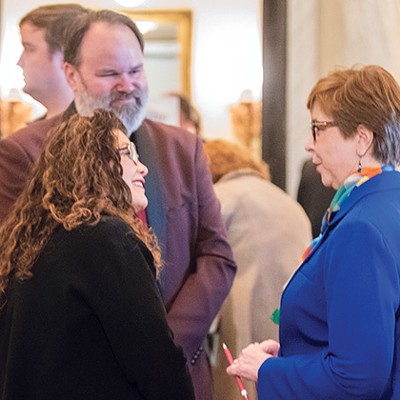If Mary Fallin takes the podium Nov. 2 as Oklahoma's governor-elect, she would cement her status as the most successful female politician the state has ever known.
It won't exactly be history in the making for the two-term congresswoman, since it's a title she already holds, but it will cap a 20-year rise for the daughter of not one, but two mayors of her hometown of Tecumseh.
Running against Washington from Washington
Coming home
Knock-down, drag-out
Fallin climbed the ladder from state representative to gubernatorial candidate fighting the battles that have defined Oklahoma politics for two decades " tort and workers' compensation reform, education policy and right-to-work.
But it took nearly four years in Washington to elevate Fallin above the fray as the state's political landscape shifted beneath her, opening the door to a run for governor based on a slate of rhetoric she has used for more than 15 years and a new argument her Democratic opponents call improbable: "If you hate Washington, vote for me. I just came from there."
Fallin has a long record in state government open to investigation, but the script hasn't changed much.
"My highest priority would be to get our economy back on track and to focus on jobs," Fallin said in a recent interview. "That means keeping our tax burden low. It means reforming areas of business like workers' comp insurance, looking at more lawsuit reform. Also, education. Creating a stronger educated workforce so we can be more attractive to jobs."
Twelve years earlier, basking in the glow of an easy re-election as lieutenant governor, Fallin told The Oklahoman, "I will work on issues important to the state: economic development, workforce development, workers' compensation and government reform, tourism, literacy and education."
Running against Washington from Washington
In August 2009, Fallin appeared in a pinstripe blue suit before a packed auditorium at Francis Tuttle Technology Center in northwest Oklahoma City.
On her left, a Boy Scout color guard peeked around their flags. On her right, two massive charts stood on easels. Those charts bore a conspicuous resemblance to those brandished the week before by Republican leaders on the House floor in their summer siege of President Barack Obama's proposed health care plan.
The crowd was raucous and obviously miffed, but not at Fallin. It was clear that the 5th Congressional District representative was not seeking her constituents' input to dutifully relay to Washington. She was testing the message that would drive her campaign for governor.
"There should be no one standing between you and your doctor, especially not the government," she told the crowd that day, referencing a simple flowchart with an arrows pointing from a stick-figure patient to a doctor to a dollar sign.
As the new car smell faded on Obama's presidency, the Republican Study Committee, a policy huddle for the more conservative members of Congress, selected Fallin as communications chairwoman.
Over the next few months, she frequently stepped in front of the cameras " flanked by Republican congressional leaders " to deliver a tightly controlled message about the Obama presidency. "Where are the jobs?" she asked the room on one such occasion.
"Congresswoman Fallin is an individual that, I think, is enable to encapsulate big issues and distill them down, to be able to communicate them to folks across this country, to say why it ought to matter to you," said Tom Price, congressman from Georgia and head of the committee.
In her two terms in Congress, Fallin has not been a prolific legislator, sponsoring 16 bills or resolutions. Most of that legislation was fiercely local in its intent, congratulating Sam Bradford on his Heisman win, for example, or seeking to bar the transfer of any Guantanamo detainees to prison facilities in Oklahoma.
Her votes fell almost wholly on party lines, including voting yes on the $700 billion TARP bailout for banks under the Bush administration. However, she has been a fierce critic of the stimulus put forward by the Obama administration less than one year following the TARP bailout that offered nearly $800 billion toward government programs to revive the economy.
"The president and (Speaker of the House Nancy) Pelosi pushing through things like the stimulus and health care were among the most divisive things I saw in Washington, not right," Fallin said.
While not prolific, Fallin did focus on networking with House leaders on both sides of the aisle, Rep. Tom Cole said.
Fallin took seats on the House Transportation and Infrastructure Committee, the Committee on Small Business and chose to go for a seat on the House Armed Services Committee. The latter provided a Republican voice to watch out for Oklahoma's interest in the Base Realignment and Closure process, Cole said.
Earlier this year, she brought the chairman of the House Transportation and Infrastructure Committee, Rep. Jim Oberstar of Minnesota, to Oklahoma for a helicopter tour of some of the state's crumbling infrastructure.
On an elevator ride in the Rayburn House Office Building recently, Cole said he asked the Democratic chairman when he got in the business of stumping around with Republican gubernatorial candidates.
Oberstar's response? "'You can't say no to Mary.'"
Coming home
Fallin seems to have avoided the scarlet letter that comes with an office near the Capitol this midterm season.
That blight has felled nearly every member of Congress seeking statewide office this primary season (See: Sen. Kay Bailey Hutchison).
The specter of Obama hangs heavy in her ads and stump speech as she seeks to saddle her Democratic opponent, Lt. Gov. Jari Askins, with the burden of the president's unpopularity in the state.
"You can't take President Obama out of races in 2010 at any level any more than you could take Bush out of races while he was president," Cole said. "The president is a very polarizing figure in this state. You've got Republican county commissioners out there trying to figure out how President Obama figures into their race."
But Fallin's Democratic opponents call that argument tenuous for a person who just came from the world of policy lunches and weekly commutes from Washington.
"Scary photos of Barack Obama are always a telling indicator of where races are," said Emily Bittner, a spokesman for the Democratic Governors' Association. "Republicans in these governor races don't want to run on their own records. Oklahomans consider her a Washington politician."
As governor, Fallin would join a cadre of Republican state executives who hope to send one of their own to the White House in 2012. In an interview, Fallin was mum on who influenced her during her time in Washington, but she gushed about several of her future gubernatorial counterparts.
Those governors have also endorsed her. Haley Barbour of Mississippi, a name often dropped in connection with the 2012 presidential contest, visited the state to stump for Fallin and raise funds. Sarah Palin also gave Fallin the "mama grizzly" seal of approval.
With Fallin at the helm and a Republican-controlled state Legislature, Oklahoma would once again become a laboratory for conservative policies.
As likely models, Fallin cited Barbour's work on tort reform, the educational restructuring Jeb Bush undertook in Florida, Chris Christie's efforts to streamline government in New Jersey, the headline-grabbing immigration policies of Jan Brewer in Arizona and the fiscal conservatism of Mitch Daniels in Indiana.
"I think it's going to be the governors that are going to lead this country back to where it needs to be going," Fallin said.
Knock-down, drag-out
In a ballroom at the flagstone and wood-paneled Biltmore Hotel in Oklahoma City, Fallin glad-handed her way to center stage at a convention for county officials in mid-September.
She quickly rattled off a litany of campaign pledges, drawing the biggest applause for measures that would divest the federal and even the state government of power and resources and hand it down to the local level.
One was her opposition to State Question 744, which would match Oklahoma's educational spending to that of surrounding states. Another was her support for a ballot measure that would allow Oklahoma to opt out of the federal health care program.
Her official campaign biography highlights the most contentious political period of her career and provides insight to how Fallin will govern the state.
"In a bold move, Fallin took over the State Senate to force a vote on Right to Work laws in an effort to keep Oklahoma's doors open for business," the biography states.
That sentence, while true, oversimplifies the knock-down, drag-out fight between Oklahoma's labor unions and business leaders over right-to-work in April 2000.
At the behest of a Republican minority, Fallin snuck into the Senate chamber and used her constitutional authority as lieutenant governor and president of the Senate to call the body into session. If Democrats had returned to the room, it would have forced a vote on the measure, which required workers to pay union dues and join up.
Then-Gov. Frank Keating called the Senate-storming Fallin "a Joan of Arc." Senate Democratic leader Stratton Taylor called her tactics an attempt to manufacture a tyrannical form of "minority" rule.
The stalemate lasted over the weekend and eventually the Senate voted down the measure. It was only months later that the right-to-work issue passed the Legislature and eventually won approval from voters statewide.
Despite her central role in the conflict, Fallin stayed out of the papers at the time, allowing Keating and Taylor to duke it out in the press. Her office merely released measured statements calling for a statewide vote on the issue.
She was in the center of the fight but not saying much about it.
Fallin definitely had the future on her mind shortly after her re-election as lieutenant governor in 1999. In a lengthy Oklahoman profile that touched on her support for a lower tax burden, real tort reform and educational improvements across the state, she was asked whether she might someday run for governor.
"Yes, I've had a little bit of on-the-job training," she said. "Grant Slater
Editor's note: A story on Democratic gubernatorial candidate Jari Askins will run Oct. 20.
top photo At a town hall meeting on Aug. 13, 2009, Mary Fallin led supporters through a flowchart on how she feels the health care system should work. Photo/Grant Slater
bottom photo Benny Bowling, Caddo County commissioner, and Ricky Taylor, Lincoln County commissioner, meet with Mary Fallin Sept. 15 at the Biltmore Hotel. Photo/Shannon Cornman











